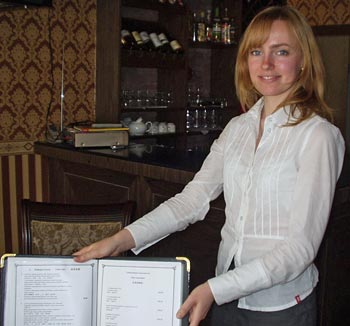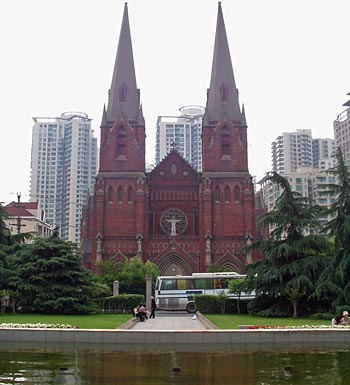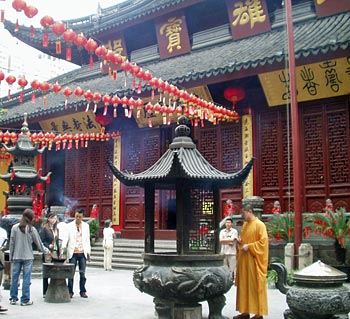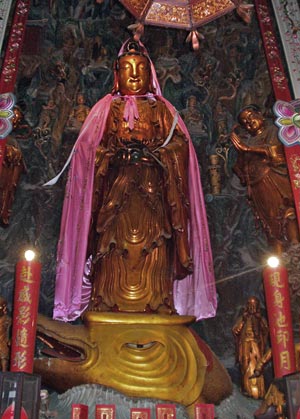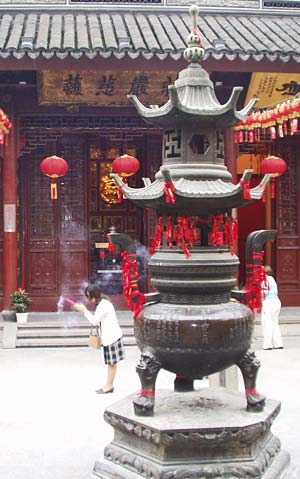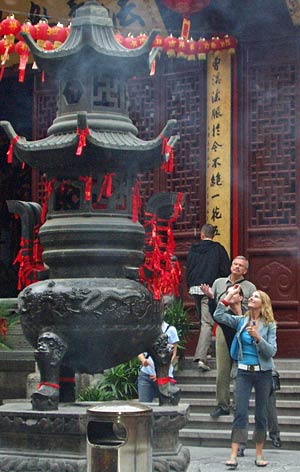This series of reports was generated in an unusual fashion. Almira Skripchenko
has a very tight schedule, travelling all around the world to play in strong
women's tournaments. Since the pictures she brought back from her trip to China
were so numerous and the stories so interesting, we decided to do the reports
with her in sections, from different parts of the world, using the Internet
and the good old telephone. Almira selected the pictures and mailed them to
us. Then, in long phone conversations she described her trip and the pictures
she had sent. We recorded and transcribed these conversations, sticking as
close to her original diction and narrative flow as we could. In this fourth
report Almira wrote the text herself in Word. Soon we'll have her doing the
image processing as well.
Last year I spent quite a long time in China, playing in a women's tournament
and the Chinese National Team League, which had been organised for the first
time in China. At first I was a bit worried, because I understood that this
would mean spending a number of months in China. But in the end curiosity won,
and I decided to do it. I am happy that I did it, because it gave me a unique
insight into the chess activities of this rising super-power of the game.
One of the key factors is that the Chinese Chess Federation is organizing
many tournaments and inviting foreign players to compete. That has brought
them great success, even though they work with their own trainers, teachers
and methods. They still have the option of inviting foreign trainers, which
will probably make them even stronger in the future.

This is my first picture of Shanghai taken on the way from the airport to
the city center. I took it from the Bund, a section of riverfront along the
Huangpu river in Shanghai which until the early 1800s was undeveloped. The British
set up their consulate and other buildings there after the Opium War.
The Oriental Pearl TV Tower is located in Pudong Park in Lujiazui, Shanghai.
The tower, surrounded by the Yangpu Bridge in the northeast and the Nanpu Bridge
in the southwest, creates a picture of "twin dragons playing with pearls".
This 468 meters high (1,536 feet) tower is the world's third tallest TV and
radio tower surpassed in height only by towers in Toronto, Canada and Moscow,
Russia.
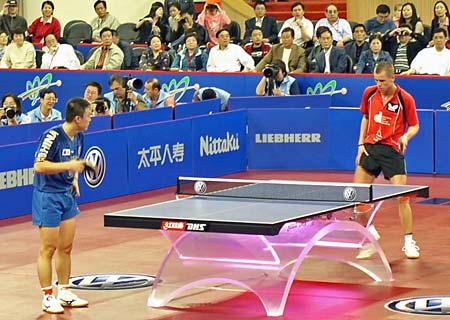
Later that day my team-mates offered me a chance to assist at the final day
of the ping-pong world championship held in Shanghai. That was my first time
at such an event and I followed all the matches quite passionately! In the above
picture you can see the Chinese player Ma Lin competing against Michael Maze
from Denmark in the men's single semi-final. Chinese have won almost every medal
in this championship. Michael Maze was one of the European gladiators to obtain
the bronze medal.
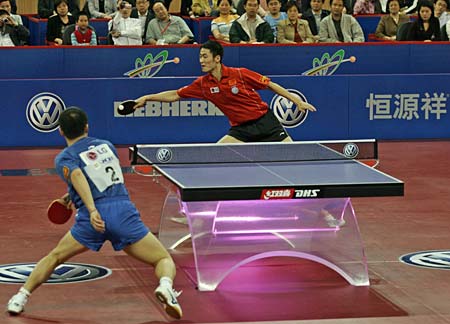
Taking into account that it was my first time in Shanghai, first time at the
ping-pong world championship and being there almost undercover, wearing some
journalist badge with a very angry Chinese face on it, the chances of meeting
someone I knew at the stadium full of 12,000 people who love ping-pong were
very remote, probably beyond the realms of the theory of probability! Well,
here you go.
While I was contemplating my curious face on the giant screen of the stadium,
a journalist sitting several rows below turns his head and greets me. This
was none other than the German columnist Hartmut Metz, who writes articles
about chess and the German Bundesliga. Now I discovered that his other passion
was ping-pong!
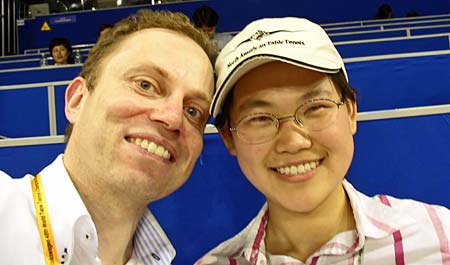
So here is Hartmut Metz with Yang Qian Ying, the Chinese journalist covering
the event and who graciously allowed me to use her pictures of the ping-pong
World Championship for my report.

Wang Nan and Zhang Yining, Olympic champions in women’s doubles, discussing
the tactics of their next point.
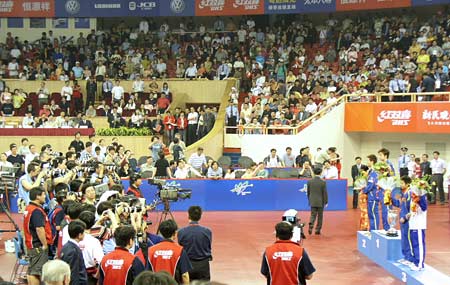
The closing ceremony with the stadium filled with 12,000 ping-pong fans!
The next day, after a night of dreaming about being a ping-pong queen, I left
for the city of Wuxi (two hours by car from Shanghai) to take part in the second
leg of the Chinese National team league. My team did pretty well and at the
end it was clear that we will qualify for the final part which will include
six best teams from the championship.
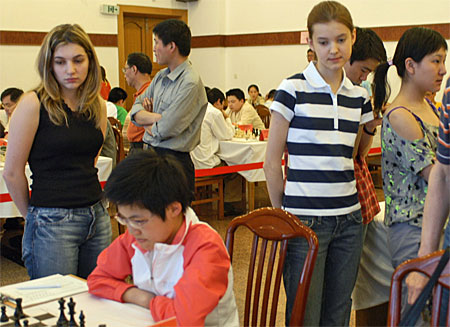
Here I am watching at the game of my 12-year-old team-mate Hou Yifan, the
"discovery" of my trip. Hou eliminated Kosintseva and Zhukova during
the last world championship. You can also see Vera Nebolsina in the black-and-white
shirt.
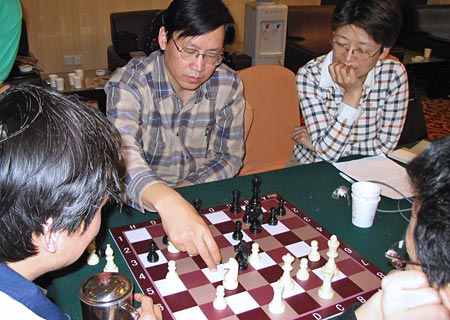
GM Ye Jiangchuan analyses his game for the journalists who were covering
the event. The reports were published in the newspapers all over the country
after each round.
WGM Zhao Xue, playing on the men’s board. Later that year she led the
Chinese women’s team at the World team’s championship in Israel.
GM George Kacheishvili, one of the "mercenaries" playing the Chinese
league.
Former women’s World Champion, GM Zhu Chen played on the first women’s
Board. We drew our game after some tactical complications.

As usual, at the end of the event Vera Nebolsina and I had to sign many autographs,
a task not for sensitive souls, given the popularity of chess in the country
with the population over a billion people! We joked with Vera that next time
we would bring a stamp with our names on it, it would certainly go faster.
Especially since Vera was trying to sign some of her autographs in Chinese
characters she learned during the trip!

After the tournament was over, I still had several days to continue my exploration.
Together with my team-mates, Vera Nebolsina and her father we decided to visit
Zhouzhuang, the ancient cultural capital in Southern China and one of the most
famous watertowns of the country. This ancient town has a history of more than
900 years with many houses built in the Ming and Qing Dynasties. There are
about 100 houses with courtyards, and 60 of them have arch gateways made of
carved bricks.
The layout of the water lanes in Zhouzhuang is perfectly arranged that it
looks like a Chinese character “#”. Many stone bridges are built
over them, linking up the households on both sides of every stream.

It is almost impossible to get the unique view of the city on foot, so like
everyone else we went on a boat-ride. Almost all of the boats were navigated
by women who sing Chinese folkloric songs during the ride.

Me, checking the settings on my camera
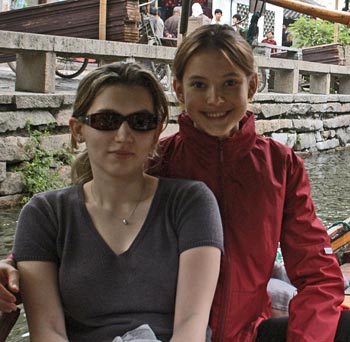
Vera enjoyed our historical escapade very much

Introducing the two new pieces on the Chinese chess board! Me and Vera Nebolsina
at the Chess House of Zhouzhuang, which was opened in 1995 by the Sports Museum
of China. It contains more than 100 exhibits.

Back to Shanghai the next day, and fully equipped with my travel guide, I
went to the Old Town to visit the Yuyuan Garden. Which was not easy to find!
In order to get there one must get through millions of traditional markets
and shops. At some point I was thinking that I probably looked like one of
those tourists at the Bastille square in Paris searching for the Bastille prison.
Contrary to those specimens, I found what I was looking for.
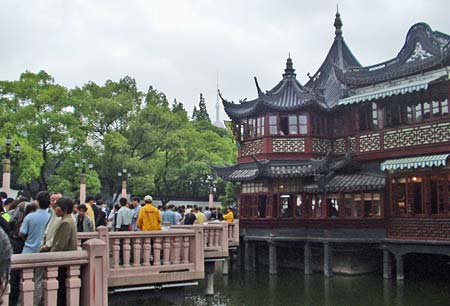
Yuyuan Garden, the Garden of Leisurely Repose, was built in the Ming dynasty.
It is the only Ming garden left in the city. The entire compound consists of
over 30 halls and is divided into six regions by tall white walls. It was built
in 1559 by the wealthy official Pan Yunduan to please his parents in their
old age. Pan Yunduan spent all his fortune in order to complete the garden.

Over the centuries the garden has declined along with the Pan family's fortunes.
The garden suffered extensive damage in the 19th century but was repaired by
the Shanghai government from 1956-1961. Still in the course of time parts of
it became residential, with schools and markets.

In the middle of the garden, the Huijing Tower area has ponds, bridges, viewing
pagodas, rock formations and large trees. It is a peaceful area to relax and
look at the different angles the garden's designers have created. And to make
some new watery friends.
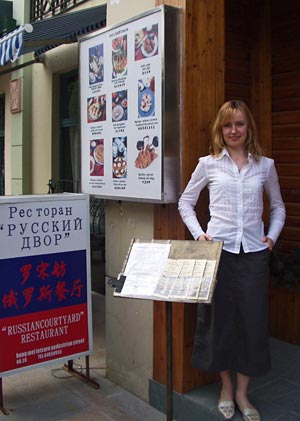
Getting tired of eating only the traditional Chinese food I went for a walk
near my hotel, fully determined to find at least a Japanese place. To my surprise,
I found a Russian restaurant in the neighbourhood. It felt like an oasis in
a desert! It is called Russian Courtyard and it serves every traditional dish
I could think of!
The restaurant owners came from Russia several years ago and were very nostalgic.
Here you have Maria presenting the very unusual choice of the menu!
The menu had clear prices, not just for the dishes but also for the articles
you might destroy, like a real Russian, during your stay in the restaurant.
My last day in Shanghai started with the visit to the St.Ignatius Cathedral.
It was opened by the Jesuits who had a church here as early as 1608. The Jesuits
were invited by a local high-ranking Míng Dynasty official, landowner,
and scientist, Xú Guangqí, who had himself been converted to
Catholicism by the Jesuits' most famous missionary to China, Matteo Ricci (1553-1610).
Built in 1906, it is noted as the No.1 catholic cathedral in the far East.
It can accommodate 2,500 worshipers at the same time.
The last landmark on my list was the Jade Buddha temple, situated in the western
part of Shanghai. In 1882, an old temple was built to keep two jade Buddha
statues which had been brought by a monk named Huigen from Burma on his way
home after paying homage to Buddha in India. The temple was destroyed during
the revolution that overthrew the Qing Dynasty. Fortunately the statues were
saved and a new temple was built on the present site in 1928. It was named
the Jade Buddha Temple.
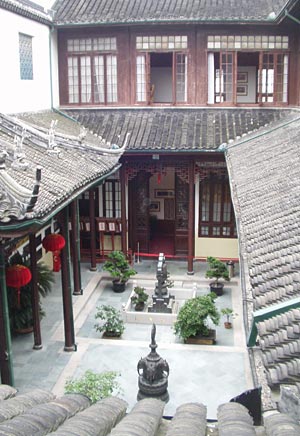
Going upstairs to view the jade Buddha statue I took the picture of the hidden
courtyard. Tourists are not allowed to take pictures of the Jade Buddha, but
photography was allowed in all other rooms.
The temple interior with a golden Buddha statue

Statues of Chinese Gods
The temple courtyard, where people perform religious rituals with incense
sticks
Western tourists trying to toss coins into the top of the monument, since
that is supposed to bring good fortune.
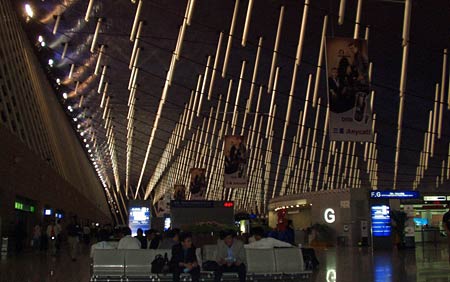
The airport which offers quite a surrealistic view for the travellers. Time
to go back to Paris!
Finally a picture that the editor of this news site is forcing me to include.
It is a glamour shot taken in Paris, where I live. Title: the author.
Previous China reports by Almira









































